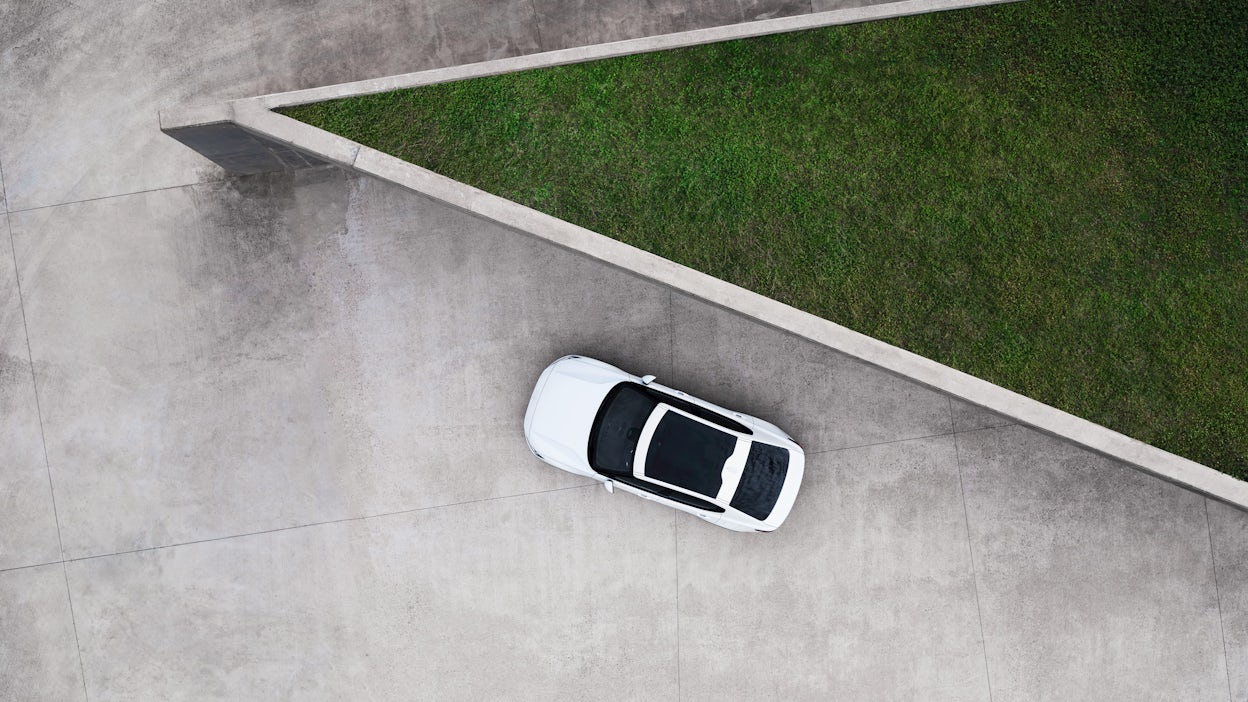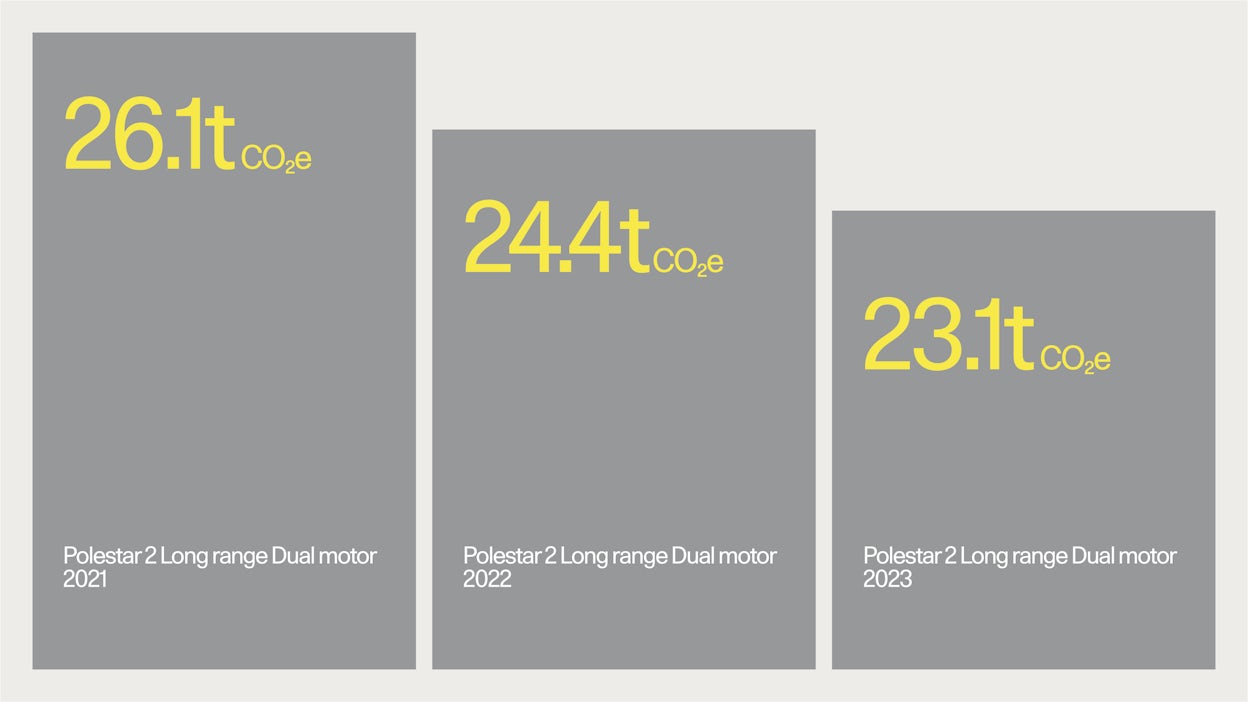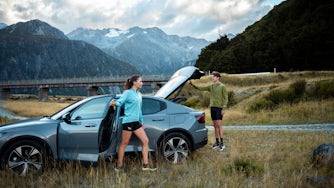LCA reports: Like I’m five
Three tonnes in three years. That’s Polestar 2’s total carbon weight loss. In case you’re wondering how we ended up with that number – and why you should care about a brand's sustainability calculations – you’re in the right place.

It’s clear that to reach climate neutrality by 2040, we have a lot of work ahead of us.
A Life Cycle Assessment (or LCA) is like an ecological storyteller, revealing a hidden footprint behind the products we love and the services we depend on. By doing so, the LCA allows people to make informed choices, supporting businesses that prioritise sustainability and minimising their own carbon footprint.
Since we all enjoy a great story (and really would like to save our planet), it's only natural for us to disclose the carbon footprint of Polestar cars, ensuring transparency and environmental responsibility.
In our LCAs, we look at all stages in the life cycle of the car, from the production of the many components that go into the vehicle, to transport, manufacturing, and distribution. Our assessment even shows how the type of electricity used when charging your car affects use phase emissions.
But what does ‘carbon footprint’ actually mean?
When we talk about a carbon footprint, we’re really talking about how much greenhouse gas is released due to the stuff we use and produce. Simply put, we’re referring to the mark our actions leave on Earth. And while they say bigger is best, in this case we want our footprint to be as small as possible.
In our LCA, we measure the car’s footprint using a special unit called carbon dioxide equivalents (CO2e). This is the same value used by the UN and the European Commission. Carbon dioxide equivalents convert the climate effects of different gases into the corresponding amount of carbon dioxide (CO2) required to create the same greenhouse effect. This means you can compare different objects, like let’s say… cars, to one another. And cars to clothing, and clothing to coffee, and so on.
Is there something Polestar does not include in these calculations?
Polestar’s LCAs are modelled according to a specific system boundary that defines both what is included – and what is not included in the analysis. This means that the construction of production facilities and their machinery are not accounted for in the calculations, nor are product losses or our employees' transport to and from work. Overall business activities such as research, product development, sales and marketing are also not included in our LCAs. The reason for that is that these greenhouse gas emissions are difficult to attribute to a specific product and are estimated to be very small in relation to the total emissions for the vehicle.
You say Polestar 2 has lost three tonnes in three years, is that a significant result?
The short answer is: yes. The slightly longer answer is: yes, but it’s not enough.
Compared with 2021’s model of Polestar 2 Long range Dual motor, we have reduced the CO2e by 3 tonnes per car (from 26.2 tonnes of CO2e, to 23.1 tonnes). That equals more than a 10% reduction, and that number will only increase. But we need to act fast.
Frida Røyne, LCA specialist at Polestar, explains: “Together with our suppliers and partners, we actively seek out solutions, and our LCA report shows areas that could be improved upon. But it’s clear that to reach climate neutrality by 2040, we have a lot of work ahead of us as we need to double down on cutting emissions in our supply chain.”

But how do you know if a CO2e figure is high, low or in between?
Glad you asked. This is a big problem, not least when you are about to make one of the biggest purchasing decisions of your life. Without something to compare it to, a single carbon dioxide equivalent figure is about as much use as a chocolate teapot.
The solution is, of course, for other car manufacturers to follow suit and show the carbon footprint of their vehicles.
And we’re starting to see this happen, with more and more car brands revealing their numbers. However, they are less transparent about how they reached their results (unwilling to share their LCA methodology), which means it’s close to impossible to interpret said number.
It's like claiming you’ve baked the world’s healthiest sponge cake – but refusing to share your recipe.
That’s why we believe we must set an industry-wide standard when it comes to conducting these reports.
What have you done to decrease the carbon footprint?
Three key actions have been key in reducing Polestar 2’s carbon footprint:
- Including a new battery in Polestar 2 long range variants in most markets*, which represents a carbon loss of 1.1 tonnes per car.
- Choosing to buy aluminium from special factories that use renewable energy (making aluminium uses a lot of energy), has seen a CO2e reduction of 1.2 tonnes per car.
- Since 2022, our manufacturing facility in Taizhou runs on 100% renewable electricity, which has resulted in a 0.5 tonne CO2e reduction per car.
However, many other materials, processes and approaches contribute to the overall carbon footprint of the car. If you’re yearning to dive a little deeper into Polestar’s strategic initiatives to minimise climate impact, we’re happy to introduce you to a fellow ecological storyteller: Polestar’s Sustainability Report.
Pro-tip: if you want to get accustomed to the sustainability lingo before plunging into the world of blockchain and offsetting, have a glance through this good-to-know wordlist.
Does decreasing the carbon footprint mean you’re also downsizing on performance?
Not at all. We’re on a quest for carbon cuts and performance-ups. Owing to the new battery in the latest Polestar 2 long range variants, we see improved cell chemistry, increased in-battery capacity, faster charging rates and extended range.
For all the essential details on the Polestar 2’s improvements, tap this link.
So, what should we do?
Given our industry has so far failed in reducing its environmental impact (did you know the car industry is set to overshoot our part of the global carbon budget by at least 75 percent), finding workable solutions may seem like rocket science.
But it’s time to debunk one of our industry’s dirty little secrets: cutting carbon doesn’t have to be that hard.
That’s why we’ve developed a Pathway report with American EV manufacturer Rivian and management consultant firm Kearney. A roadmap to help our fellow automakers get on track for a more sustainable car industry.
In the report, we’ve identified concrete actions that car manufacturers can take between now and 2030 to address the climate crisis. It’s so non-rocket science, one could even summarize the report in three (okay, maybe four) sentences:
First and foremost, we need to accelerate the transition to EVs. Secondly, electric vehicles must be charged with renewable energy to reach their full potential. Finally, as we move from gas-guzzling cars to green energy-powered EVs, we need to shift our focus from tailpipe emissions to manufacturing (or slightly fancier: supply chain decarbonization). This is particularly important for energy-intensive materials and parts, like the battery, steel, and aluminium.
Equipped with this new knowledge, you are now ready to get down to the nitty-gritty of things. Happy exploring!
*Korea being the exception.


